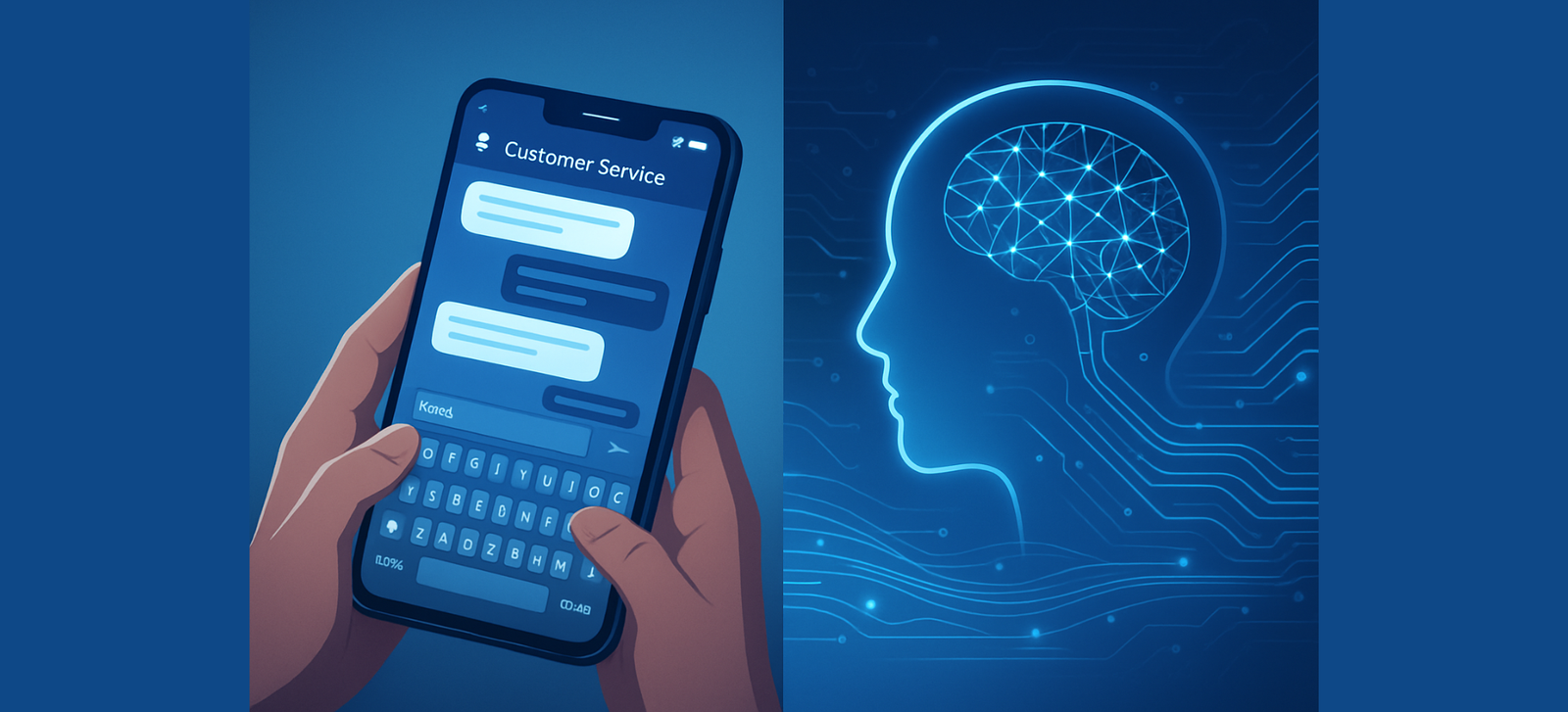AI chatbots are transforming customer service with 24/7 support, instant responses, and human-like interactions. Discover how businesses are leveraging this technology for competitive advantage.
I had a customer service interaction last week that blew my mind.
Not because it was exceptionally good or remarkably bad, but because halfway through the conversation, I realized I wasn’t talking to a human.
The “agent” understood context, remembered previous interactions, solved my problem efficiently, and even threw in a bit of humor. Only when I asked a highly technical question did the handoff to a human specialist reveal the truth.
I’d just experienced the future of customer service—and it felt surprisingly… human.
The Quiet Revolution
While we’ve been debating whether AI will replace human jobs, chatbots have quietly revolutionized customer service behind the scenes.
Today’s AI-powered customer service isn’t the clunky “press 1 for billing” systems of the past. These are sophisticated conversational AI platforms that can understand natural language, maintain context across interactions, and learn from every conversation.
According to Gartner’s 2024 research, 80% of customer service interactions will be handled by AI by 2025, up from 15% in 2022. <cite>¹</cite> This isn’t gradual change—it’s a complete transformation of how businesses interact with customers.
The Technology Behind the Magic
Modern customer service chatbots are powered by Large Language Models (LLMs) similar to ChatGPT, but fine-tuned for specific business contexts.
These systems combine:
- Natural Language Processing (NLP) for understanding customer intent
- Machine Learning algorithms that improve with each interaction
- Integration with business databases for real-time information access
- Sentiment analysis to detect customer emotions and adjust responses accordingly
MIT researcher Dr. Cynthia Breazeal’s work on social robotics shows that humans naturally anthropomorphize AI systems, attributing human-like qualities to machines that demonstrate empathy and understanding. <cite>²</cite> Modern chatbots leverage this psychological tendency to create more satisfying customer experiences.
The 24/7 Advantage
The most obvious benefit of AI customer service is availability. Chatbots don’t sleep, take breaks, or call in sick.
But the real advantage isn’t just timing—it’s consistency. While human agents have good days and bad days, chatbots maintain the same level of service quality regardless of external factors.
Customer experience expert Dr. Blake Morgan’s research shows that 86% of customers are willing to pay more for better customer experience, and 24/7 availability is consistently ranked as a top priority. <cite>³</cite> AI chatbots deliver this expectation as a baseline feature.
The Personalization Engine
Advanced chatbots don’t just provide generic responses—they personalize interactions based on customer history, preferences, and behavior patterns.
When a chatbot knows your previous purchases, support tickets, and communication preferences, it can provide relevant solutions faster than a human agent reading through case notes.
Salesforce’s State of the Connected Customer report reveals that 84% of customers say being treated like a person, not a number, is very important to winning their business. <cite>⁴</cite> AI paradoxically enables more personal service by instantly accessing comprehensive customer data.
The Emotional Intelligence Factor
Perhaps the most impressive advancement in chatbot technology is emotional intelligence capabilities.
Modern AI can detect frustration, urgency, or satisfaction in customer messages and adjust tone and approach accordingly. They can escalate to human agents when emotional complexity exceeds their capabilities.
Dr. Rosalind Picard’s research at MIT’s Affective Computing Group demonstrates that machines can recognize and respond to human emotions with surprising accuracy, sometimes outperforming humans in consistency of emotional response. <cite>⁵</cite>
The Multilingual Marketplace
AI chatbots excel in multilingual environments, providing consistent service across languages without requiring human translators or multilingual staff.
This is particularly valuable for businesses operating globally, where hiring native speakers for every supported language would be prohibitively expensive.
Google’s research on neural machine translation shows that AI can now achieve near-human accuracy in many language pairs, enabling truly global customer service at scale. <cite>⁶</cite>
The Learning Loop
Unlike traditional software, AI chatbots improve continuously through machine learning algorithms that analyze successful and unsuccessful interactions.
Each conversation provides data that helps the system:
- Recognize new types of customer inquiries
- Improve response accuracy
- Identify knowledge gaps that need human intervention
- Optimize conversation flows for efficiency
Stanford researcher Dr. Andrew Ng emphasizes that “AI is the new electricity”—a foundational technology that improves every system it touches through continuous learning and optimization. <cite>⁷</cite>
The Human-AI Collaboration Model
The most successful implementations don’t replace humans entirely—they create efficient human-AI partnerships.
Chatbots handle routine inquiries: password resets, order status, basic troubleshooting, and frequently asked questions. Human agents focus on complex problems, emotional situations, and relationship building.
This collaboration model improves job satisfaction for human agents by eliminating repetitive tasks and allowing them to focus on high-value interactions that require empathy, creativity, and complex problem-solving.
Harvard Business School’s research on human-AI collaboration shows that the best outcomes occur when AI augments human capabilities rather than replacing them entirely. <cite>⁸</cite>
The Cost Revolution
The economics of AI customer service are compelling for businesses of all sizes.
Traditional call centers require significant infrastructure: office space, equipment, hiring, training, and ongoing management. AI chatbots require initial development investment but have minimal ongoing operational costs.
McKinsey & Company’s analysis shows that AI chatbots can reduce customer service costs by up to 30% while improving response times and availability. <cite>⁹</cite> For startups and small businesses, this technology democratizes access to professional-grade customer service.
The Privacy and Security Challenge
AI customer service raises important questions about data privacy and security.
Chatbots process vast amounts of customer data, including personal information, purchase history, and communication patterns. Ensuring this data is protected and used ethically is crucial for maintaining customer trust.
Privacy researcher Dr. Cathy O’Neil warns that AI systems can perpetuate biases and privacy violations if not carefully designed and monitored. <cite>¹⁰</cite> Businesses implementing AI customer service must prioritize transparency and data protection.
The Customer Expectation Shift
AI chatbots are reshaping customer expectations across all industries.
Customers now expect:
- Instant responses to simple inquiries
- Context awareness across communication channels
- Proactive support based on behavior patterns
- Seamless handoffs between AI and human agents
These raised expectations create competitive pressure for businesses to adopt AI customer service or risk appearing outdated.
The Implementation Reality
Despite the benefits, implementing AI customer service isn’t plug-and-play.
Successful deployments require:
- Clear understanding of customer service workflows
- Integration with existing business systems
- Ongoing training and optimization
- Careful balance between automation and human touch
- Continuous monitoring for bias and accuracy
The Future Landscape
The next generation of AI customer service will likely include:
- Voice-based AI assistants for phone support
- Predictive customer service that solves problems before customers experience them
- Emotional AI that provides therapeutic support for stressed customers
- Augmented reality integration for visual troubleshooting
Customer service isn’t just being improved by AI—it’s being completely reimagined.
The Competitive Imperative
In an increasingly digital marketplace, customer service often determines business success more than product features or pricing.
AI chatbots provide smaller businesses with enterprise-level customer service capabilities, while helping larger organizations scale support without proportional cost increases.
The question isn’t whether AI will transform customer service—it’s whether your business will lead or lag in this transformation.
Companies that embrace AI customer service thoughtfully, prioritizing customer experience over cost-cutting, will gain significant competitive advantages in the digital economy.
The revolution is already here. The only question is: are you part of it?
Ready to explore more marketing and business innovations?
Subscribe below for weekly insights on digital transformation, AI applications, and the future of customer experience.
Stay ahead of the curve with practical analysis and strategic insights.
Your competitive advantage starts with knowledge.
Citations:
- Gartner, Inc. “Gartner Predicts 80% of Customer Service Organizations Will Apply Generative AI Technology by 2025.” Gartner Press Release, 2024.
- Breazeal, Cynthia. “Designing Sociable Robots.” MIT Press, 2002.
- Morgan, Blake. “Customer Experience: What, How and Why Now.” Forbes, 2019.
- Salesforce Research. “State of the Connected Customer Report.” Salesforce, 2023.
- Picard, Rosalind W. “Affective Computing.” MIT Press, 1997.
- Wu, Yonghui, et al. “Google’s Neural Machine Translation System.” arXiv preprint, 2016.
- Ng, Andrew. “AI is the New Electricity.” Stanford AI Conference, 2017.
- Wilson, H. James, and Paul R. Daugherty. “Human + Machine: Reimagining Work in the Age of AI.” Harvard Business Review Press, 2018.
- McKinsey & Company. “The Age of AI: Artificial Intelligence and the Future of Work.” McKinsey Global Institute, 2023.
- O’Neil, Cathy. “Weapons of Math Destruction: How Big Data Increases Inequality.” Crown, 2016.


Leave a Reply